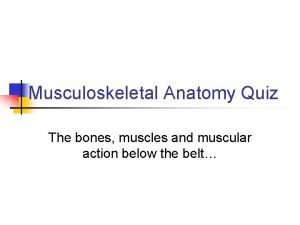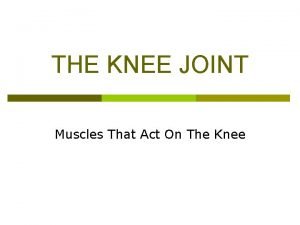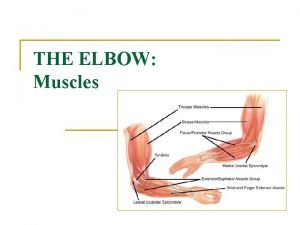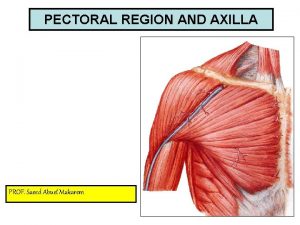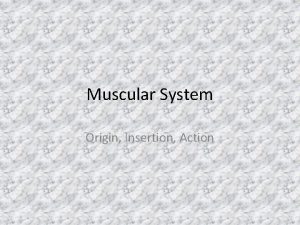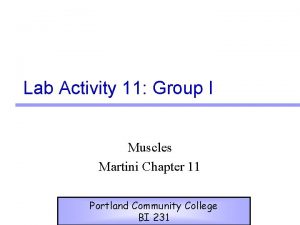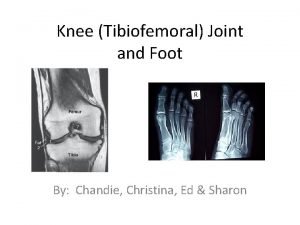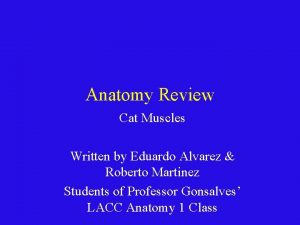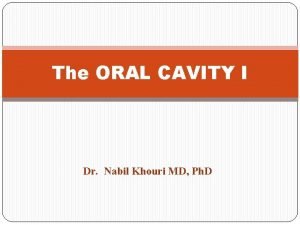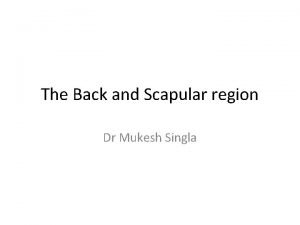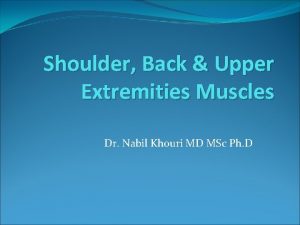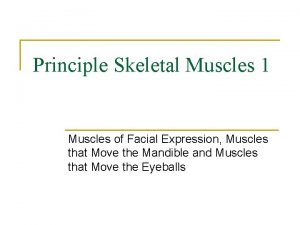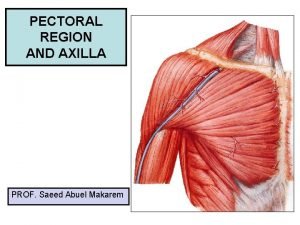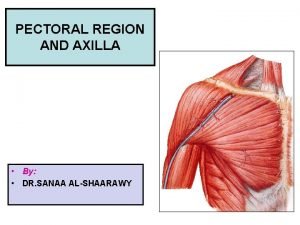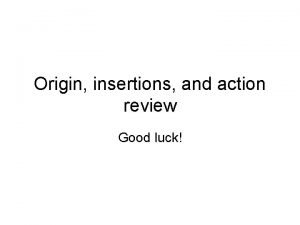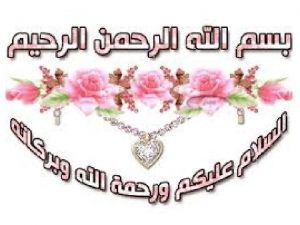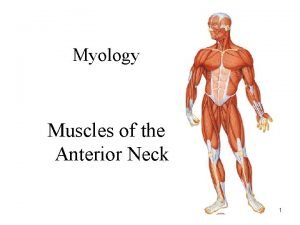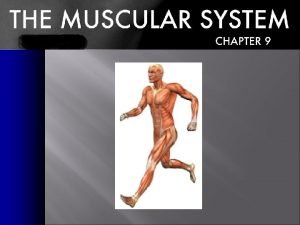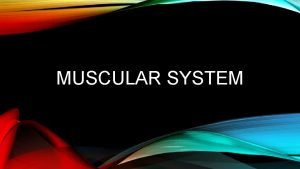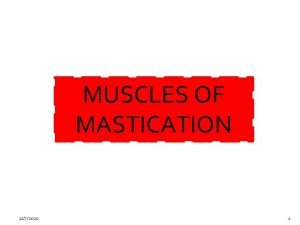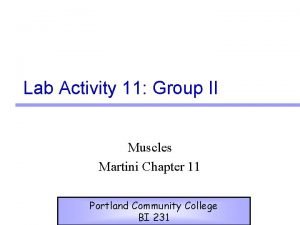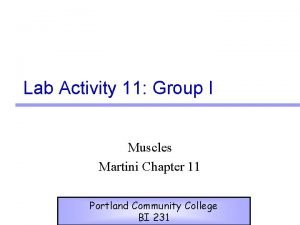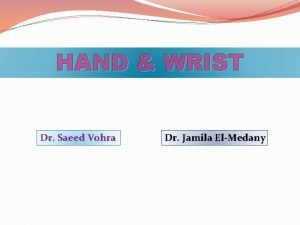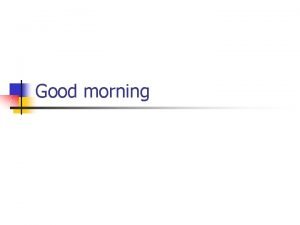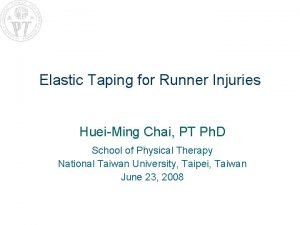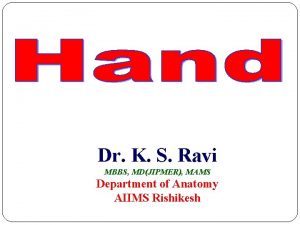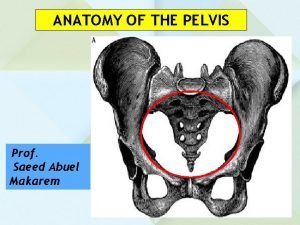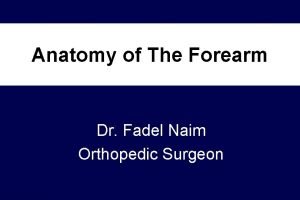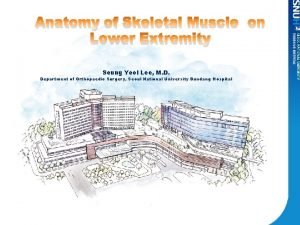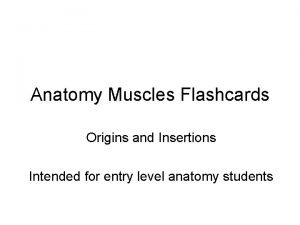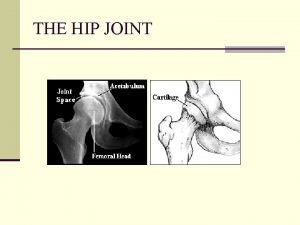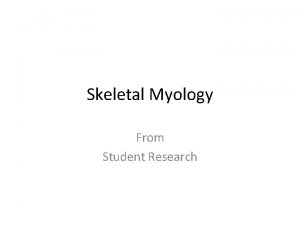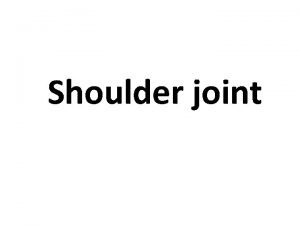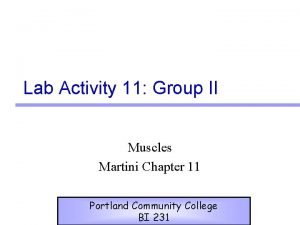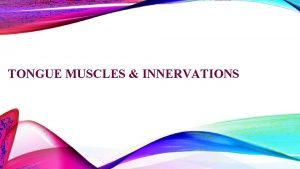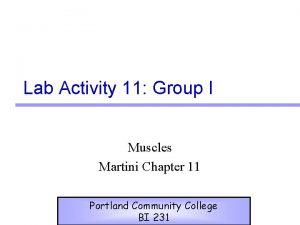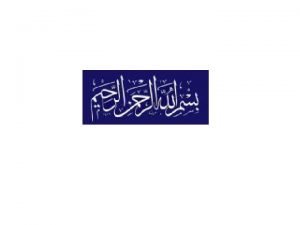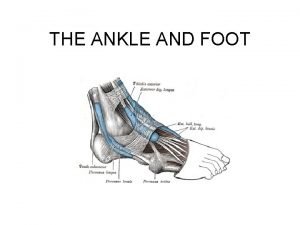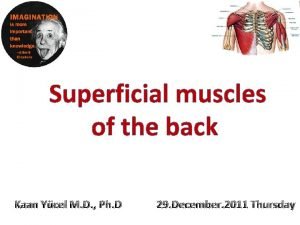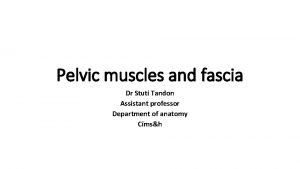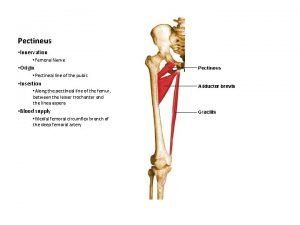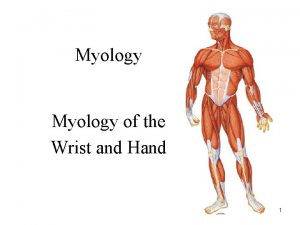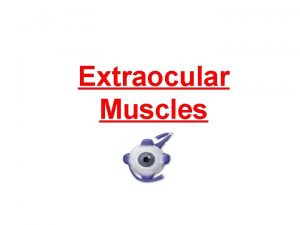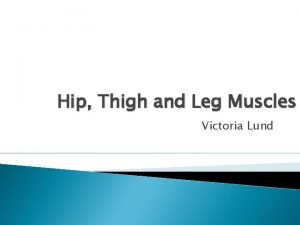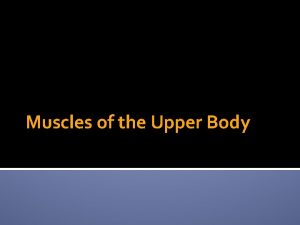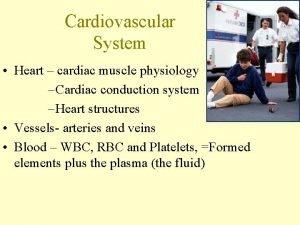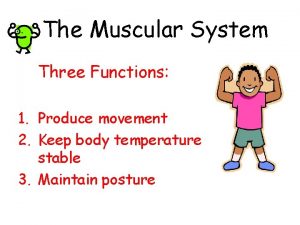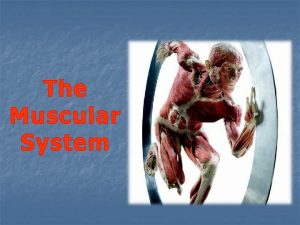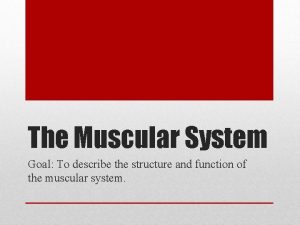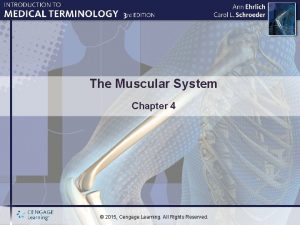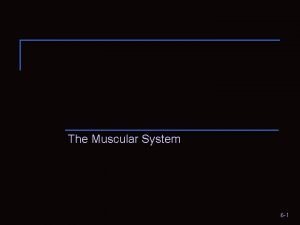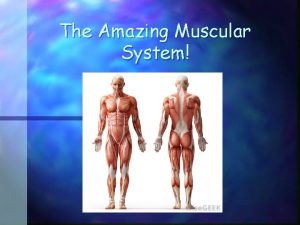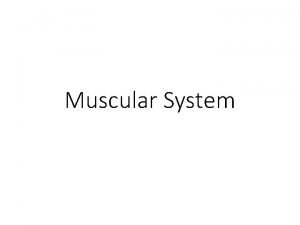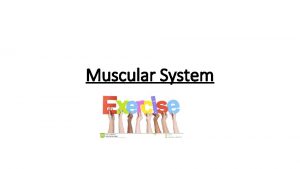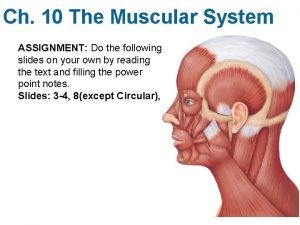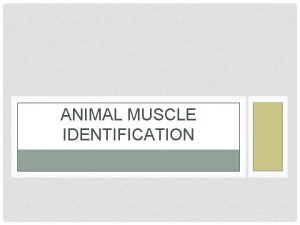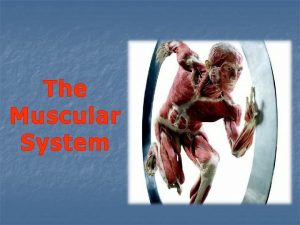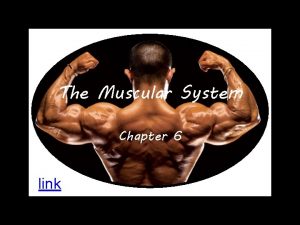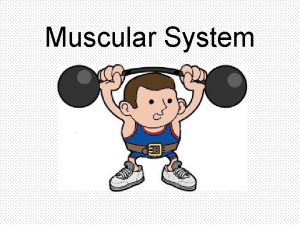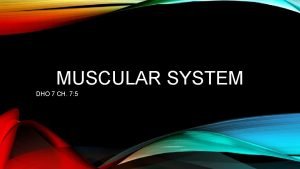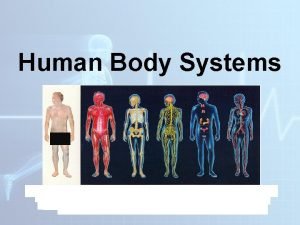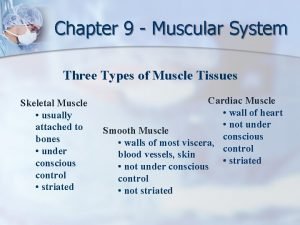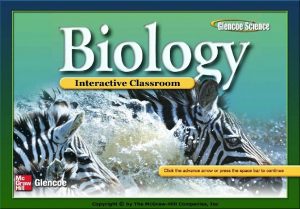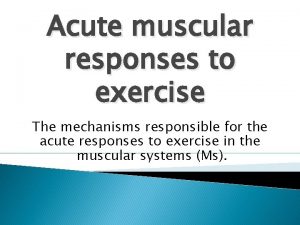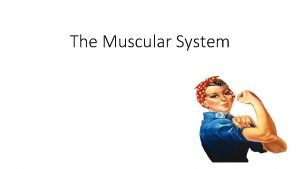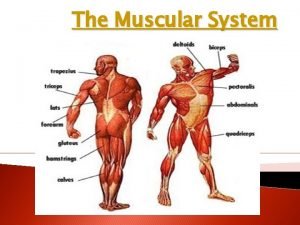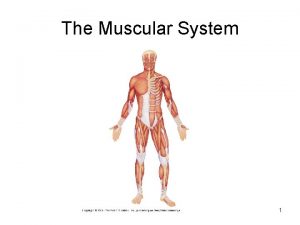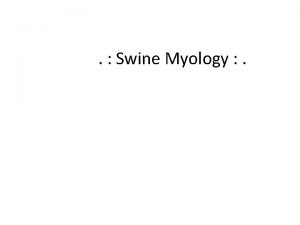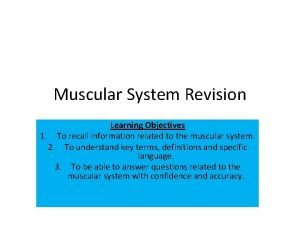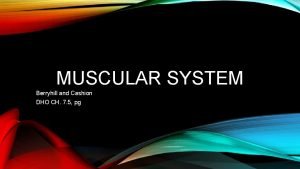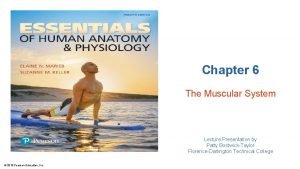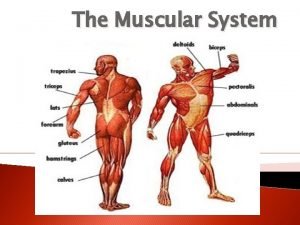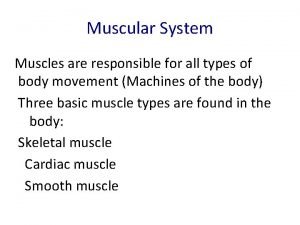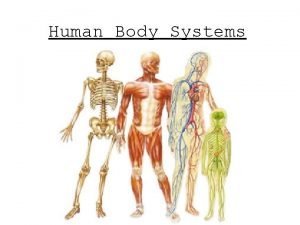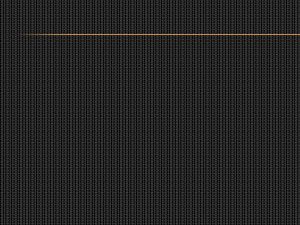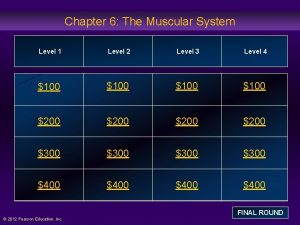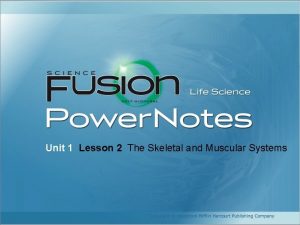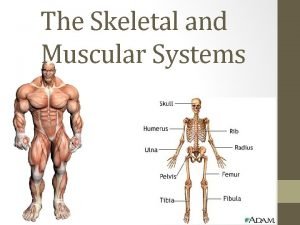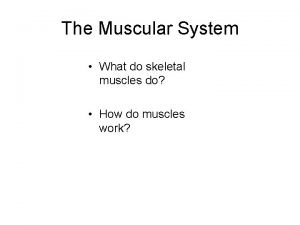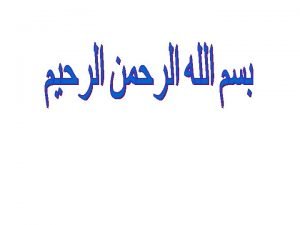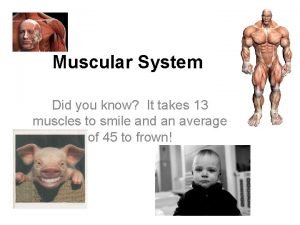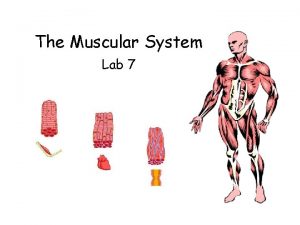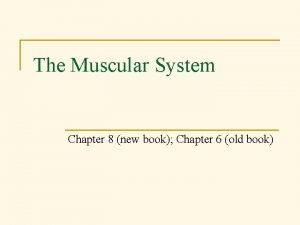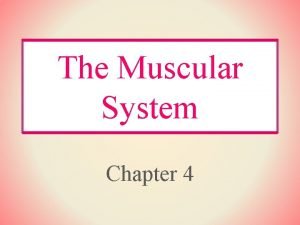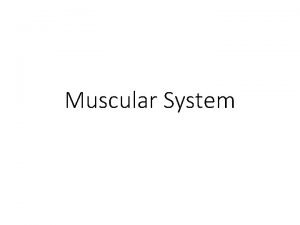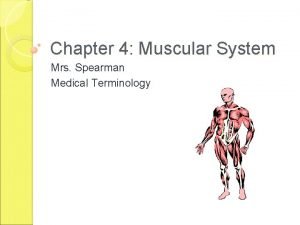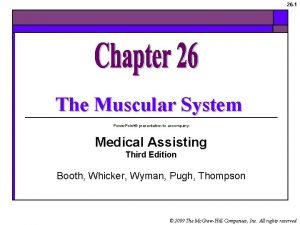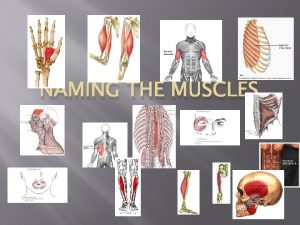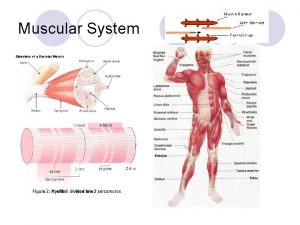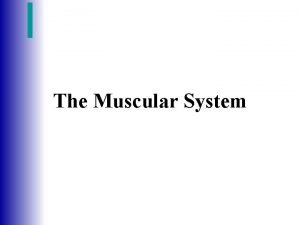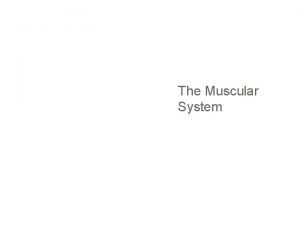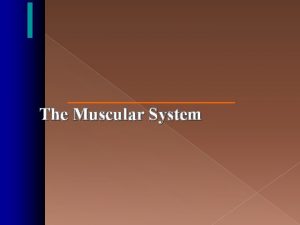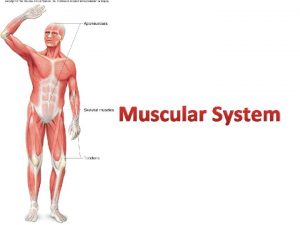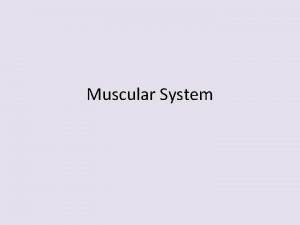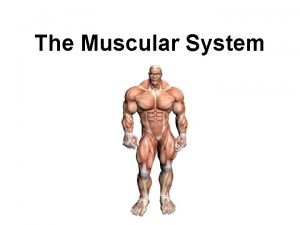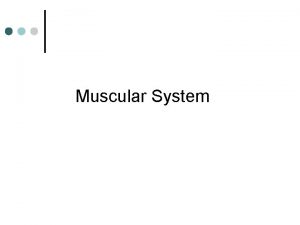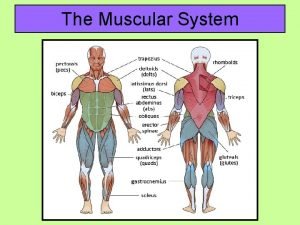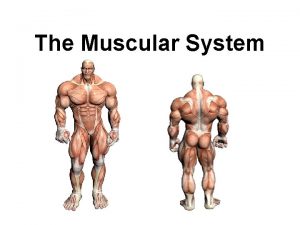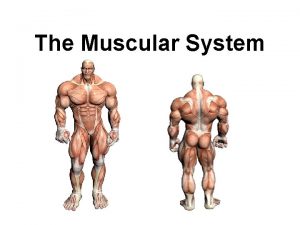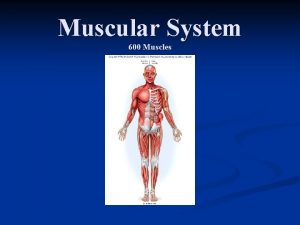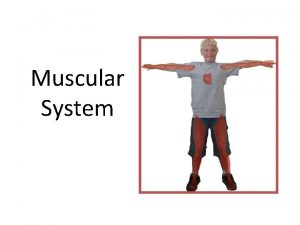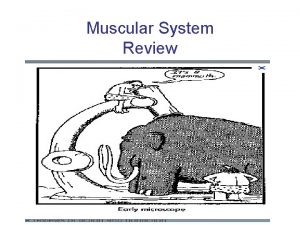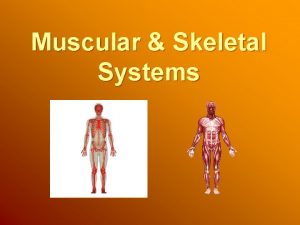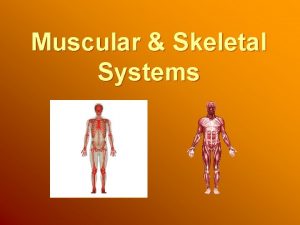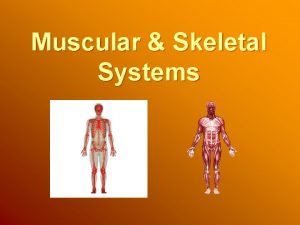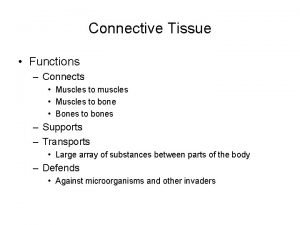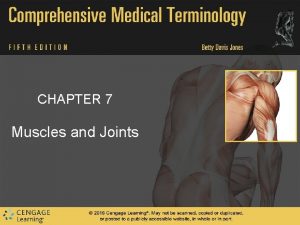Muscular System Origin Insertion Action Muscles of the

















































































































- Slides: 113

Muscular System Origin, Insertion, Action

Muscles of the Scalp • Occipitofrontalis – Frontal Belly – Occipital Belly

Frontalis • O: Galea aponeurotica • I: Skin of eyebrows • A: Raises eyebrows, wrinkles forehead skin

Occipitalis • O: Occipital Bone • I: Galea aponeurotica • A: Pulls scalp posterior

Muscles of Facial Expression

Orbicularis Occuli • O: Frontal and Maxillary bones • I: Tissue of eyelid • A: Blinking, squinting

Orbicularis Oris • O: Maxilla and Mandible • I: Encircles mouth, angles of mouth • A: Closes lips, purses and protrudes lips (kissing and whistling)

Muscles of Mastication

Masseter • O: Zygomatic arch and maxilla • I: Mandible • A: Closes jaw by elevating mandible

Temporalis • O: Temporal fossa • I: Coronoid process of mandible • A: Closes jaw (elevates and retracts mandible)

Buccinator • O: Maxilla and mandible • I: Orbicularis oris • A: Compresses cheek (whistling and sucking), holds food between teeth (during chewing)

Muscles of the Anterior Neck and Throat (Swallowing) • Digastric • All of the muscles that attach to the hyoid

Digastric • O: Mandible and mastoid process • I: Hyoid bone • A: Elevate hyoid during speech and swallowing, • Open mouth and depress mandible

Anterolateral Neck Muscles

Sternocleidomastoid • O: Sternum and Clavicle • I: Mastoid process of temporal bone • A: B/L – head flexion; unilateral – laterally flex towards and rotates away from itself

Scalenes • O: Transverse processes (anterior) of cervical vertebrae • I: 1 st two ribs • A: elevate first two ribs (inspiration), flex and rotate neck

Intrinsic Muscles of the Back

Splenius Capitus • O: Ligamentum nuchae, spinous processes of C 7 – T-6 • I: Occipital bone, mastoid process of temporal bone • A: B/L – extend head; unilateral – lateral flex and rotate towards

Splenius Cervicis • O: Ligamentum nuchae, spinous processes of C 7 – T-6 • I: Transverse Processes of C 2 – C 4 • A: B/L – extend neck; unilateral – lateral flex and rotate towards

Erector Spinae (Sacrospinalis) • Iliocostalis (Most lateral) • Longissimus (Intermediate) • Spinalis (Most medial)

Iliocostalis • O: iliac crest (lumborum); inferior 6 ribs (thoracis); ribs 3 to 6 (cervicis) • I: ribs (lumborum and thoracic); TPs of C 6 -C 4 (cervicis) • A: B/L - Extend spine, posture; unilateral – lateral flex towards

Longissimus • O: TPs of vertebrae • I: Superior TPs and superior ribs; capitis portion inserts on Mastoid process • A: B/L – extend spine; unilateral – laterally flex; capitis portion extends head and rotates towards

Spinalis • O: Spines of upper lumbar and lower thoracic vertebrae • I: Spines of upper thoracic and cervical vertebrae • A: Extends spine, maintains erect posture

Quadratus Lumborum • O: Iliac crest • I: TPs of upper lumbar vetebrae and 12 th rib • A: Unilaterally – laterally flexes spine; b/l – extends L-spine

Muscles of the Thorax (Breathing)

External Intercostals • O: Inferior border of rib above • I: Superior border of rib below • A: Pull ribs toward one another, elevate rib cage; INSPIRATION • Fibers run down and anterior

Internal Intercostals • O: Superior border of rib below • I: inferior border of rib above • A: Draw ribs together and depress rib cage; EXPIRATION • Fibers run down and posterior

Diaphragm • O: Inferior surface of rib cage and sternum, costal cartilages, lumbar vertebrae • I: Central tendon • A: Flattens on contraction; Prime mover of Inspiration

Muscles of the Anterior and Lateral Abdominal Wall

Rectus Abdominus • O: Pubic crest and symphysis • I: Xiphoid process and costal cartilages ribs 5 -7 • A: Flex and rotate lumbar region, stabilize pelvis during walking

External Oblique • O: Outer surfaces of lower eight ribs • I: Linea alba • A: B/L – aid in trunk flexion; unilateral – trunk rotation and lateral flexion

Internal Oblique • O: Lumbar fascia, iliac crest • I: linea alba, pubic crest, costal margin last 3 – 4 ribs • A: B/L – aid in trunk flexion; unilateral – trunk rotation and lateral flexion

Transverse Abdominus • O: Inguinal ligament, lumbar fascia, cartilage of last 6 ribs, iliac crest • I: Linea alba, pubic crest • A: Compresses abdominal contents

Muscles of the Anterior Thorax

Pectoralis Minor • O: Anterior surface of ribs 3 -5 • I: Coracoid process of scapula • A: Ribs fixed – draws scapula forward and down; scapula fixed – draws rib cage superior

Muscles of the Posterior Thorax

Trapezius • O: Occipital bone, ligamentum nuchae, spines from C 7 to T 12 • I: Acromion and spine of scapula, lateral 1/3 of clavicle • A: Superior – elevates scapula; middle – retract (adduct) scapula; inferior – depress scapula

Levator Scapulae • O: Transverse processes of C 1 – C 4 • I: Medial border of scapula (superior to spine) • A: Elevates / adducts scapula, laterally flexes neck to same side

Rhomboids • O: Spinous processes of C 7 – T 5 • I: Medial border of scapula • A: Retract (adduct) scapula, stabilize scapula

Muscles Crossing the Shoulder Joint

Pectoralis Major • O: Sternal end of clavicle, sternum, cartilage ribs 1 -6 • I: Intertubercular sulcus of humerus • A: Flexes arm, medially rotates arm, adducts arm (climbing, throwing, pushing)

Latissimus Dorsi • O: Fascial connection to spines of T 7 – L 5, lower 3 -4 ribs, iliac crest • I: Intertubercular sulcus of humerus • A: Arm extension, arm adductor, medially rotates arm (hammering, swimming)

Deltoid • O: Embraces insertion of trapezius; lateral third of clavicle, acromion, spine of scapula • I: Deltoid tuberosity of humerus • A: Abducts arm; anterior fibers – flexion, medial rot. ; posterior fibers – extension, lateral rot.

Rotator Cuff Muscles • • • SITS Supraspinatus Infraspinatus Teres Minor Subscapularis

Supraspinatus • O: Supraspinous fossa of scapula • I: Greater tubercle of humerus • A: Stabilizes shoulder joint. Prevents downward dislocation. Initiates shoulder abduction.

Infraspinatus • O: Infraspinous fossa of scapula • I: Greater tubercle of humerus posterior to supraspinatus insertion • A: Holds head of humerus in glenoid cavity, shoulder stabilization

Teres Minor • O: Lateral border of scapula (dorsal surface) • I: Greater tubercle of humerus inferior to infraspinatus insertion • A: Stabilize shoulder, adducts arm

Subscapularis • O: Subscapular fossa of scapula • I: Lesser tubercle of humerus • A: Medial rotation of humerus, stabilizes shoulder joint

Teres Major • O: Inferior angle of scapula • I: Intertubercular sulcus of humerus • A: Extends, medially rotates, and adducts humerus

Coracobrachialis • O: Coracoid process of scapula • I: Medial humerus • A: Flexion and adduction of humerus

Muscles Crossing the Elbow Joint

Posterior

Triceps Brachii • O: Scapula and humerus • I: Olecranon process of ulna • A: Forearm extensor

Anterior

Biceps Brachii • O: Short head – coracoid process; long head – lip of glenoid cavity • I: Radial tuberosity • A: Flexes elbow joint, supinates forearm

Brachialis • O: Front of distal humerus • I: Styloid process of ulna • A: Forearm flexor

Brachioradialis • O: Distal end of humerus • I: Styloid process of radius • A: Forearm flexion

Muscles of the Forearm

Anterior Superficial

Pronator Teres • O: Medial epicondyle of humerus • I: Lateral radius • A: Pronates forearm

Flexor Carpi Radialis • O: Medial epicondyle of humerus • I: 2 nd and 3 rd metacarpals • A: Flexor of wrist, abducts hand

Palmaris Longus • O: Medial epicondyle of humerus • I: Skin and fascia of palm • A: Wrist flexor

Flexor Carpi Ulnaris • O: Medial epicondyle of humerus, olecranon process and posterior ulna • I: Pisiform, hamate, and 5 th metacarpal • A: Wrist flexion, adducts hand

Flexor Digitorum Superficialis • O: Medial epicondyle of humerus, coronoid process of ulna, shaft of radius • I: Middle phalanges 2 -5. • A: Flexes wrist and middle phalanges

Anterior Deep

Flexor Pollicis Longus • O: Anterior radius, interosseus membrane • I: Distal phalanx of the thumb • A: Flexes distal phalanx of the thumb

Flexor Digitorum Profundus • O: Anteromedial surface of ulna and interosseus membrane • I: Distal phalanges 2 -5 • A: Finger flexion

Posterior Superficial

Extensor Carpi Radialis • O: Lateral epicondyle of humerus • I: 3 rd metacarpal • A: Extends wrist

Extensor Carpi Digitorum • O: Lateral epicondyle of humerus • I: Distal phalanges 2 -5 • A: Finger extension, extends wrist

Extensor Carpi Ulnaris • O: Lateral epicondyle of humerus, posterior ulna • I: 5 th metacarpal • A: Extends wrist, adducts wrist

Posterior Deep

Supinator • O: Lateral epicondyle of humerus, proximal ulna • I: Proximal radius • A: Supinates forearm

Extensor Pollicis • O: Dorsal radius and ulna, interosseus membrane • I: Proximal and distal phalanx of thumb • A: Extends thumb

Thenar Muscles

Abductor Pollicis • O: Posterior radius and ulna, interosseus membrane • I: 1 st metacarpal and trapezium • A: Abducts and extends thumb, abducts wrist

Opponens Pollicis • O: Flexor retinaculum and trapezium • I: Anterior 1 st metacarpal • A: Opposition: moves thumb to touch tip of middle finger

Adductor Pollicis • O: Metacarpals 2 -4 • I: Medial side of proximal phalanx of thumb • A: Adducts thumb

Muscles Crossing the Hip and Knee Joints

Anterior and Medial Muscles

Iliopsoas • O: Iliac crest, TPs, bodies, and discs of T 12 – L 5 • I: Lesser trochanter of femur • A: Thigh flexor, trunk flexor, lateral flexion of trunk

Sartorius • O: Anterior Superior Iliac Spine (ASIS) • I: Posterior, medial aspect of proximal Tibia • A: Flexes, abducts, and laterally rotates thigh; flexes knee

Medial Compartment of the Thigh

Gracilis • O: Body of pubis • I: Medial surface of Tibia • A: Adducts thigh; flexes thigh; medially rotates thigh

Anterior Compartment of the Thigh

Quadriceps Femoris • Four Heads – Rectus Femoris – Vastus Lateralis – Vastus Medialis – Vastus Intermedius

Rectus Femoris • O: Anterior Inferior Iliac Spine (AIIS) • I: Patella and tibial tuberosity • A: Extends knee; flexes thigh at hip

Vastus Lateralis • O: Greater trochanter • I: Patella and tibial tuberosity • A: Extends and stabilizes knee

Vastus Medialis • O: Linea aspera, intertrochanteric line • I: Patella and tibial tuberosity • A: Extends knee; inferior fibers stabilize patella

Vastus Intermedius • O: Anterior and lateral surface of proximal femur • I: Patella and tibial tuberosity • A: Extends knee

Tensor Fascia Latae • O: Iliac crest, ASIS • I: Iliotibial tract • A: Flexes and abducts thigh; pulls iliotibial tract taut

Posterior Muscles

Gluteus Maximus • O: Dorsal ilium, sacrum, coccyx • I: Gluteal tuberosity of femur, ITB • A: Extends thigh

Gluteus Medius & Minimus • O: Surface of ilium • I: Greater trochanter of femur • A: Abducts and medially rotates thigh

Lateral Rotators

Piriformis • O: Anterolateral surface of sacrum • I: Greater trochanter of femur (superior border) • A: Laterally rotates thigh

Posterior Compartment of the Thigh

Hamstrings • Biceps femoris (two heads) • Semitendinosus • Semimembranosus

Biceps Femoris • O: Ischial tuberosity • I: Head of fibula and lateral condyle of tibia • A: Extends thigh; flexes knee; laterally rotates leg

Semitendinosus • O: Ischial tuberosity • I: Medial aspect of Tibia • A: Extends thigh; flexes knee; medially rotates leg

Semimembranosus • O: Ischial tuberosity • I: Medial condyle of tibia; lateral condyle of femur • A: Extends thigh; flexes knee; medially rotates leg

Muscles of the Leg

Anterior Compartment

Tibialis Anterior • O: Upper 2/3 of tibia, interosseus membrane • I: Medial cuneiform and 1 st metatarsal bone • A: Dorsiflexion of foot

Extensor Digitorum • O: Proximal ¾ of fibula; interosseous membrane • I: Middle and distal phalanges of toes 2 -5 • A: Toe extension; dorsiflexes foot

Extensor Hallucis • O: Fibula; interosseous membrane • I: Distal phalanx of great toe • A: Extends great toe; dorsiflexes foot

Lateral Compartment

Peroneus (Fibularis) • O: Lateral fibula • I: Long tendon curves under foot to the 1 st metatarsal and medial cuneiform (longus); fifth metatarsal (brevis) • A: Plantar flexes foot; everts foot.

Posterior Compartment

Triceps Surae • Gastrocnemius (Two heads) • Soleus

Gastrocnemius • O: Two heads from medial and lateral condyles of the femur • I: Calcaneus • A: Plantar flexes foot; can flex knee when the foot is dorsiflexed

Soleus • O: Superior tibia and fibula; interoesseous membrane • I: Calcaneus • A: Plantar flexes foot

Flexor Digitorum Longus • O: Posterior Tibia • I: Distal phalanges 2 -5 • A: Plantar flexion of foot and flexion of the toes.
 Soleus origin and insertion
Soleus origin and insertion Semi tendinosis
Semi tendinosis Origin insertion of triceps
Origin insertion of triceps Serratus anterior muscle
Serratus anterior muscle Muscle origin insertion action
Muscle origin insertion action Origin of teres minor
Origin of teres minor Flexor hallucis brevis origin and insertion
Flexor hallucis brevis origin and insertion Spinodeltoid origin insertion action
Spinodeltoid origin insertion action Difference between strength and endurance
Difference between strength and endurance Teeth marks on tongue
Teeth marks on tongue Scapular region
Scapular region Anconeus origin and insertion
Anconeus origin and insertion Brachioradialis origin and insertion
Brachioradialis origin and insertion Gastrocnemius muscle origin and insertion
Gastrocnemius muscle origin and insertion Fascia clavipectoral
Fascia clavipectoral Serratus anterior origin and insertion
Serratus anterior origin and insertion Good insertions
Good insertions Diaphragm origin insertion
Diaphragm origin insertion Scalenes
Scalenes Flexor carpi ulnaris origin and insertion
Flexor carpi ulnaris origin and insertion Insertion vs origin
Insertion vs origin Menisco temporal compartment
Menisco temporal compartment Medial epicondyle of humerus
Medial epicondyle of humerus Triceps origin and insertion
Triceps origin and insertion Adductor pollicis origin and insertion
Adductor pollicis origin and insertion Intercostal space
Intercostal space Outcropper muscles
Outcropper muscles Normal shoulder extension
Normal shoulder extension Supraspinatus taping
Supraspinatus taping Thin diaphragm
Thin diaphragm Adductor pollicis origin and insertion
Adductor pollicis origin and insertion Pelvic shape types
Pelvic shape types Flexor carpi ulnaris innervation
Flexor carpi ulnaris innervation Soleal line tibia
Soleal line tibia Muscle origin and insertion flashcards with pictures
Muscle origin and insertion flashcards with pictures Gluteus maximus adduction
Gluteus maximus adduction Scapular region
Scapular region Deltoid muscle
Deltoid muscle Muslce
Muslce Abductor digiti minimi
Abductor digiti minimi Genioglossus
Genioglossus I muscles
I muscles L
L Plantar flexion ankle muscles
Plantar flexion ankle muscles Anterior axillary fold
Anterior axillary fold Cims&h
Cims&h Pectineal line of femur
Pectineal line of femur Flexor pollicis longus origin and insertion
Flexor pollicis longus origin and insertion Ganglion
Ganglion Quad muscles action
Quad muscles action Supraspinatus muscle action
Supraspinatus muscle action Muscles action
Muscles action 3 sodium out 2 potassium in
3 sodium out 2 potassium in Three functions of muscular system
Three functions of muscular system Primary functions of muscular system
Primary functions of muscular system Main function of muscular system
Main function of muscular system Chapter 4 the muscular system learning exercises answer key
Chapter 4 the muscular system learning exercises answer key Unit 6:5 muscular system
Unit 6:5 muscular system Simple muscular system diagram
Simple muscular system diagram What is the root word for muscle
What is the root word for muscle Muscular system label
Muscular system label Chapter 6 the muscular system
Chapter 6 the muscular system Muscular system head and neck
Muscular system head and neck Sheep muscular system
Sheep muscular system Navigating the body regions of the body
Navigating the body regions of the body Whats the function of the muscular system
Whats the function of the muscular system Chapter 6 the muscular system figure 6-9
Chapter 6 the muscular system figure 6-9 Whats in the muscular system
Whats in the muscular system Chapter 7:5 muscular system
Chapter 7:5 muscular system Chapter 9 muscular system
Chapter 9 muscular system Structures of the muscular system
Structures of the muscular system Types of muscles
Types of muscles Chapter 32 section 3 the muscular system answer key
Chapter 32 section 3 the muscular system answer key Muscular system response to exercise
Muscular system response to exercise Whats the muscular system
Whats the muscular system Major muscles
Major muscles Microscopic anatomy of skeletal muscle figure 6-2
Microscopic anatomy of skeletal muscle figure 6-2 Muscular system levels of organization
Muscular system levels of organization Superficial muscular system
Superficial muscular system Hog anatomy
Hog anatomy Muscular system learning objectives
Muscular system learning objectives Chapter 7:5 muscular system
Chapter 7:5 muscular system Chapter 6 the muscular system
Chapter 6 the muscular system Chapter 4 the muscular system labeling exercises
Chapter 4 the muscular system labeling exercises What are the major functions of the muscular system
What are the major functions of the muscular system Anterior torso muscles
Anterior torso muscles 3 functions of the muscular system
3 functions of the muscular system Muscular system
Muscular system Chapter 6 the muscular system
Chapter 6 the muscular system Chapter 6 the muscular system
Chapter 6 the muscular system Chapter 10 the muscular system
Chapter 10 the muscular system Lesson 2 muscle storyboard
Lesson 2 muscle storyboard Muscular diagram
Muscular diagram Major skeletal muscles
Major skeletal muscles Muscular system
Muscular system Major muscles
Major muscles Muscle system
Muscle system Muscular system
Muscular system Whats the job of the muscular system
Whats the job of the muscular system Muscle diagram
Muscle diagram Chapter 8 the muscular system
Chapter 8 the muscular system Cardiac muscle tissue
Cardiac muscle tissue Sarcolemma
Sarcolemma Myalgia is abnormal softening of muscle tissue.
Myalgia is abnormal softening of muscle tissue. Skeletal and muscular system
Skeletal and muscular system Muscular system
Muscular system Hình ảnh bộ gõ cơ thể búng tay
Hình ảnh bộ gõ cơ thể búng tay Lp html
Lp html Bổ thể
Bổ thể Tỉ lệ cơ thể trẻ em
Tỉ lệ cơ thể trẻ em Chó sói
Chó sói Chụp phim tư thế worms-breton
Chụp phim tư thế worms-breton Alleluia hat len nguoi oi
Alleluia hat len nguoi oi Môn thể thao bắt đầu bằng từ chạy
Môn thể thao bắt đầu bằng từ chạy
